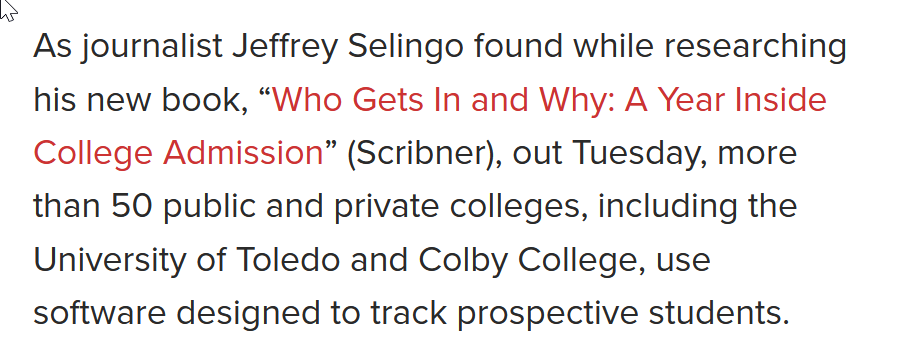
Thread:
Sigh. We know what this means: College admissions offices do not--because they cannot--visit every high school.
We do not have the staff or the time to visit every high school in our state each year, and we're a public university. hechingerreport.org/a-big-reason-r…
Sigh. We know what this means: College admissions offices do not--because they cannot--visit every high school.
We do not have the staff or the time to visit every high school in our state each year, and we're a public university. hechingerreport.org/a-big-reason-r…
The problem of having people cover admissions who do not know--or haven't taken the time to learn--the business is that you get headlines like this based on faulty assumptions, namely, that "recruiting = visiting a high school."
Our job and our profession looks simple, as witnessed by anyone who's heard a trustee say, "we'll call on our alumni volunteers to help with recruiting." As if they'd do that when they need help with accounting or architecture or athletic coaching. Admissions is a profession.
It's not a simple job, and the nuances of it are not well understood by a cursory glance. Most people think of "recruiting" as that face-to-face, personal interaction they might have had with someone in admissions at their high school.
That's a tiny sliver of it.
That's a tiny sliver of it.
By that definition, I'm guessing most colleges didn't "recruit" the majority of students they enroll.
This is not suggesting that one admissions officer interacting with one student can't make a difference. We all know it can and does.
This is not suggesting that one admissions officer interacting with one student can't make a difference. We all know it can and does.
If you go to that big high school with 1,500 seniors and 1,500 juniors, you can just as easily walk into the office to be greeted by (get ready) no one. No one in the counseling office; no students to see you,;and no one at the desk to even direct you to the right place.
Because just as we underfund admissions offices, we underfund high school offices. It's not that that counselor doesn't *want* to talk to you: They could be dealing with a literal life and death situation for a student.
And that's more important. By a mile.
And that's more important. By a mile.
And visiting small high schools a long way from home is not a good investment for the university. Again, it can be transformative for the one student at the one school who happens to be able to meet with you during that 40 minutes you happen to be there.
College fairs help. But the economic realities mean we have to optimize our outcomes. We don't have a choice, because if the class isn't full, the person who replaces you next year will see quickly what side the bread is buttered on.
We have limited resources and great demands. Like everyone does. And we recruit in other ways, sending emails and printed material far and wide. It's not free, and it's not cheap, but it's more efficient than travel.
In that sense, let's hope COVID has shown us that we can be available to students to speak one-on-one (screen-to-screen) to almost anyone from anywhere in the world at (almost) any time. In that scenario, no one has an advantage.
And let's stop thinking of recruiting as "visiting high schools." Almost no one who enrolls had their first contact via a high school visit.
That model has been dead for over 20 years, although we still do it for good reason (connecting with colleagues in counseling offices.)
That model has been dead for over 20 years, although we still do it for good reason (connecting with colleagues in counseling offices.)
Most people in most admissions offices are happy to help when we can. But we can't do everything, let alone go everywhere.
We'd like to. We can't. So ask, but understand, too. Please.
We'd like to. We can't. So ask, but understand, too. Please.
Oh, and #EMTalk
• • •
Missing some Tweet in this thread? You can try to
force a refresh









